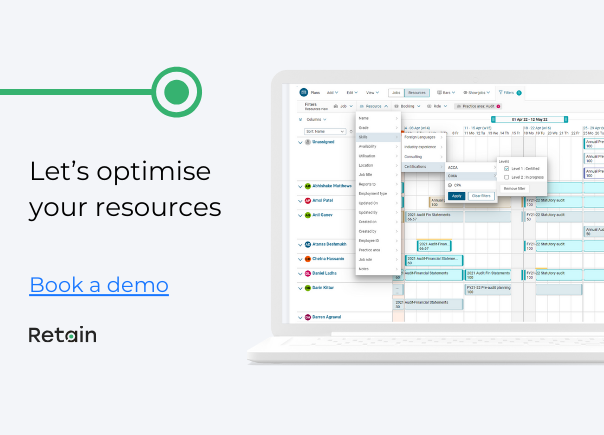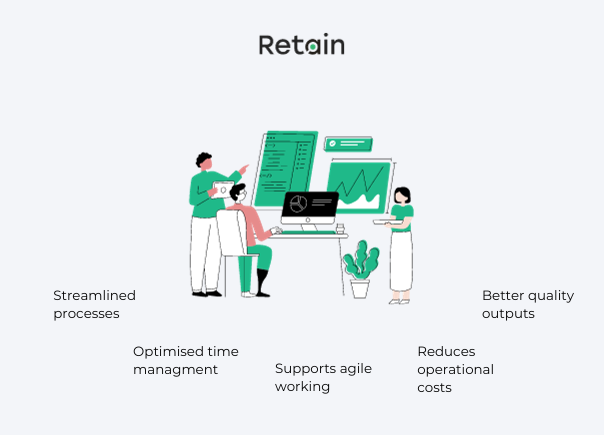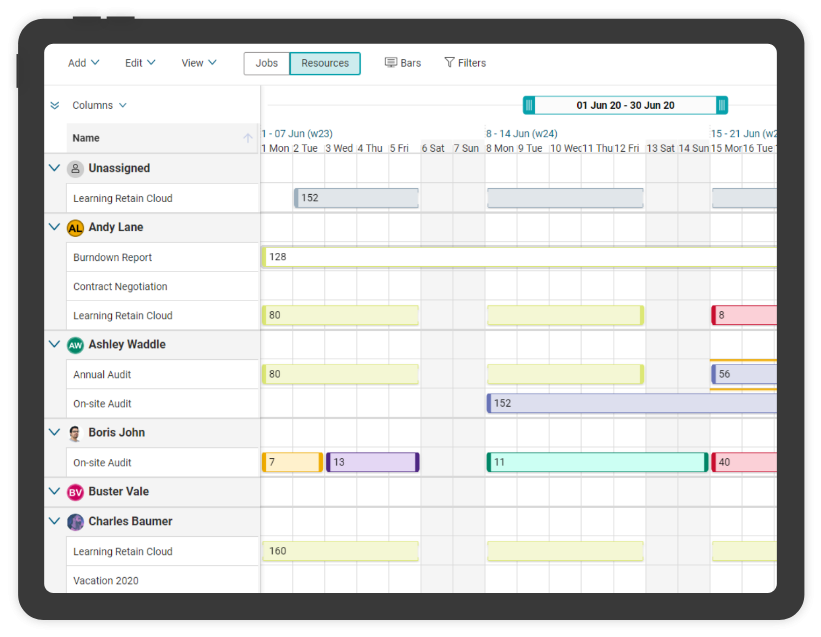If you have responsibility for resource scheduling, you’ve probably found yourself in an uncomfortable position. One that’s forcing you to face up to the efficiency and productivity losses a lack of resource scheduling software investment is having on your business.
For too long, manual approaches to resource scheduling have reigned supreme, but poor utilisation, a lack of efficiency, and poor team dynamics highlight the growing need for a better approach. One that caters to the needs of your organisation, its clients, and its people.
In this blog, we’ll help you quantify the impact of resource scheduling software on team dynamics and business efficiency—and why it’s time to ditch old ways.

What is resource scheduling software?
Resource scheduling software is a digital tool designed to streamline the allocation and management of a professional services’ company's most valuable asset—its people. Resource scheduling software allows businesses to schedule, allocate, and track where and how much project team members are being used.
Resource scheduling software is also handy for helping teams collaborate more effectively and increasing visibility into who is working on what.
Here are just a handful of the key benefits resource scheduling software brings:
🟢 AI-powered smart scheduling: Algorithms match projects to the best-fit resources based on skills, capacity, availability, and more to drive efficiency.
🟢 Centralised planning: Plan personnel, equipment, budgets, and other resources from a central platform accessible company-wide and integrated with your other business systems.
🟢 Forecast and future plan: Predict future demand, identify constraints, and model different scenarios to maximise resource capacity.
🟢 Real-time tracking: Monitor project progress and resource utilisation in real-time to rapidly respond to changes.
🟢 Reporting & analytics: Generate insightful reports on resource and project performance to inform better planning.
Bottom line: Unlike traditional manual resource scheduling methods reliant on static calendars and complex spreadsheets, modern resource scheduling software offers dynamic, real-time solutions. It adapts to changes instantaneously, ensuring all team members are on the same page.
And, platforms, like Retain, often come equipped with features like time tracking, workflow management, and capacity management, providing a holistic view of resource availability and utilisation. (You can check out a quick overview here.)
Resource scheduling software’s impact on team dynamics
The beauty of resource scheduling software, is that it doesn't just assign people to projects; it revolutionises the way teams interact and collaborate to. By simplifying and optimising the scheduling process, it plays a key role in shaping healthier, more cohesive team dynamics.
Here’s a few ways it does this:
Better collaboration and communication
With a single source of truth for schedules, everyone stays informed. This clarity means no more misunderstandings and creates a culture of open communication. The right software also enables teams to coordinate on client projects effortlessly, aligning their efforts without the back-and-forth typically seen with manual scheduling.
Empowering team members
Real-time updates mean teams can adapt quickly to changes, whether it's a shift in project deadlines or unexpected resource availability. Plus, shared access (with access controls) empowers individuals to take more ownership of their schedules, enhancing a sense of autonomy and responsibility.
Improved transparency and trust
Resource scheduling software fosters a transparent work environment, where tasks and deadlines are visible to all. This clarity builds trust among team members, as everyone understands their roles and responsibilities, nurturing a culture of fairness and mutual respect.
Supports remote and hybrid working
The software is pivotal in supporting remote and hybrid work models, ensuring team members remain connected and coordinated, irrespective of their location. This feature is invaluable in today's flexible work culture, keeping teams cohesive and productive.
Reduced burnout and better workloads
By evenly distributing tasks and managing workloads, the software plays a crucial role in preventing burnout. This leads to a healthier work atmosphere and heightened job satisfaction, contributing to the overall wellbeing of the team.
Culture of continuous learning
The software aids in identifying skill gaps and potential training opportunities, fostering a culture of continuous learning and development. This not only enhances individual skill sets but also contributes to the collective growth of the team.
Improved inclusivity and diversity
Through equitable distribution of opportunities, resource scheduling software ensures an inclusive work environment. It supports diversity within teams by making sure all members have equal access to resources and opportunities.
Better conflict resolution
Efficiently identifying and resolving conflicts related to resource allocation is another key benefit. The software helps maintain team harmony by quickly addressing and mitigating scheduling conflicts, ensuring a smooth workflow.
Side note: as teams become more cohesive and communication barriers are broken down, the overall atmosphere shifts towards one of unity and shared purpose.
How resource scheduling software boosts efficiency

Similarly, resource scheduling software is not just about keeping calendars in order; it's a strategic move that significantly boosts efficiency and productivity within an organisation.
Here’s how resource scheduling software makes a tangible difference to efficiency:
1. Streamlined scheduling processes
By automating scheduling, the software significantly reduces time spent on administrative duties, allowing team members to focus on more strategic work. It also optimises the use of available resources, ensuring no talent or equipment is underutilised or overburdened.
2. Optimised time management
Resource scheduling software streamlines time management by prioritising tasks efficiently. This leads to maximised productivity, as team members focus on high-impact activities, reducing time spent on less crucial tasks.
3. Supports agile working methods
The right resource scheduling platform supports agile working by allowing teams to quickly adapt to changing priorities and project demands. This flexibility is crucial for success in dynamic professional services business environments, enabling swift and effective responses to new challenges.
4. Reduces operational costs
Efficient resource allocation directly translates into reduced operational costs. By avoiding overstaffing and underutilisation, the software ensures resources are optimised, enhancing overall cost-effectiveness.
5. Enhanced quality of output
When resources are assigned to the right projects, the quality of work improves. The software ensures team members are working on projects aligned to their skills and preferences and are neither overburdened nor idle, creating an environment where high-quality output becomes the standard.
6. Simplified compliance and reporting
Scheduling software helps in adhering to industry standards and eases the reporting process with full audit trails, making it an invaluable tool for regulatory compliance. This aspect is particularly beneficial for businesses in highly regulated sectors.
To sum up, resource scheduling software actively enhances the efficiency and productivity of a team. From optimising time management to reducing operational costs, the software not only saves time and money but also improves the quality of output.
Transform efficiency and team dynamics with resource scheduling software
From enhancing project management to enabling data-driven decision making, the benefits of resource scheduling software creates a collaborative, efficient, and forward-thinking workplace culture.
By balancing people's skills, availability, and capacity against the workload, a platform like Retain empowers managers to make people-positive and bottom-line friendly decisions at the same time.
What makes Retain stand out is that its resource scheduling features are powerful, easy-to-use, and visual. It empowers you to:
🟢 Find the right people for every project: With a centralised resource pool detailing resources’ role, skills, cost, seniority, availability, and workload.
🟢 Surface who has capacity to take on work: Get complete visibility into all resources’ availability, capacity, and utilisation.
🟢 Schedule resources super-fast: Drag-and-drop and AI-powered smart scheduling assigns the right people to the right projects in a flash.
🟢 Say goodbye to clashes: Easily plan a balanced workload across all your resources for happier teams, fewer delays, and less budget and schedule variances.
Note: You can also plan resources in days, hours, or FTEs, making sure you don't become hostage to a specific way of working and tracking things.

The timeline view offers you the view of your entire resource pool and everyone's booking’s on projects, highlighting any conflicts or workload opportunities to optimise. You can also switch to capacity charts for powerful reporting and filtering capabilities. Check out how Myla Duggans from BPM reduced 100’s of admin hours and optimised scheduling performance with Retain.
Retail resource scheduling software can also support complex projects that need to be updated in actual time, with real-time scheduling features.
Built with the purpose to make resource planning easier, Retain is constantly releasing new features. You can check out the latest update here. Recently, Retain has introduced enhanced audit trails, levelled up its scenario planning, and rolled out project status fields.


